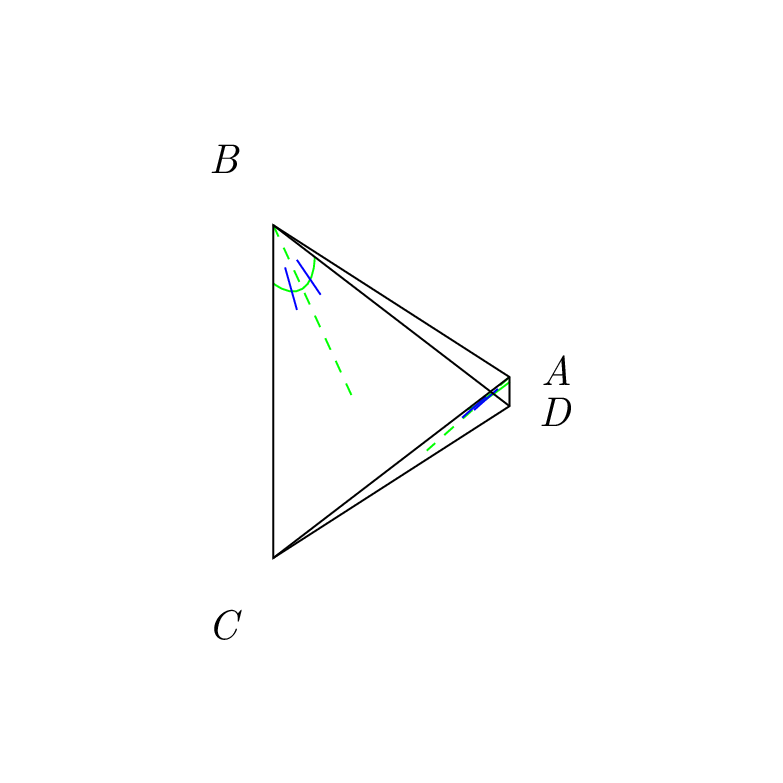TikZ being fickle about manually drawing tick marks for marking congruent angles
To me this looks like a tetrahedron. If you want to draw a 45 degree line on one of its faces, just choose the coordinate system such that the x and y directions are along two edges and the origin is at their intersection. Then you do not need any intersections nor a complicated calc syntax, and you can even adjust the viewing angles at will.
\documentclass[tikz,border=3.14mm]{standalone}
\usepackage{amsmath}
\usepackage{amsfonts}
\usepackage{tikz-3dplot}
\begin{document}
\foreach \X in {0,5,...,355}
{\tdplotsetmaincoords{90+40*cos(\X)}{\X}
\begin{tikzpicture}
\path[use as bounding box] (-3,-3) rectangle (3,3);
\begin{scope}[tdplot_main_coords]
%vertices of tetrahedron get defined
\path (1,1,1) coordinate (A) (-1,-1,1) coordinate (B) (-1,1,-1) coordinate (C)
(1,-1,-1) coordinate (D) (0,0,0) coordinate (O);
%
%The labels for the vertices of the tetrahedron are typeset.
\foreach \X in {A,B,C,D}
{\path (O) -- (\X) node[pos=1.4]{\textit{\X}};}
%angle{CAD} and \angle{CBD}
\begin{scope}[shift={(A)},x={(C)},y={(D)},transform shape]
\draw[green] (0.175,0) arc(0:90:0.175);
\draw[green,dashed] (0,0) -- (0.35,0.35);
\draw[blue] (0.05,0.1) -- (0.15,0.2) (0.1,0.05) -- (0.2,0.15);
\end{scope}
\begin{scope}[shift={(B)},x={(C)},y={(D)}]
\draw[green] (0.175,0) arc(0:90:0.175);
\draw[green,dashed] (0,0) -- (0.35,0.35);
\draw[blue] (0.05,0.1) -- (0.1,0.2) (0.1,0.05) -- (0.2,0.1);
\end{scope}
\end{scope}
%edges
\draw (A) -- (B) -- (C) -- (D) -- cycle;
\draw (A) -- (C);
\draw (B) -- (D);
\end{tikzpicture}
}
\end{document}

ANSWER TO YOUR QUESTION: You did not name an intersection, it got the name intersection-1, you were using it immediately, and everything went fine. Then you computed yet another intersection, which overwrote intersection-1. So when you were using intersection-1 for the second blue line, it was no longer the coordinate you thought it would be, and hence the second blue line(s) were off. Here is a minimally repaired code with annotations.
\documentclass{amsart}
\usepackage{amsmath}
\usepackage{amsfonts}
\usepackage{tikz}
\usetikzlibrary{calc,intersections}
\begin{document}
\begin{tikzpicture}
%A cyclic quadrilateral is drawn.
\path (-1.5,0) coordinate (A) (80:1.5) coordinate (B) (330:1.5) coordinate (C) (0,-1.5) coordinate (D);
%
%The quadrilateral and its diagonals are drawn.
\draw (A) -- (B) -- (C) -- (D) -- cycle;
\draw (A) -- (C);
\draw (B) -- (D);
%The labels for the vertices of the cyclic quadrilateral are typeset.
\draw let \p1=($(A)-(B)$), \n1={atan(\y1/\x1)} in node[anchor={0.5*(\n1+315)-180}, inner sep=0, font=\footnotesize] at ($(A) +({0.5*(\n1+315)}:0.15)$){\textit{A}};
\path let \p1=($(A)-(B)$), \n1={atan(\y1/\x1)}, \p2=($(B)-(C)$), \n2={atan(\y2/\x2)} in node[anchor={0.5*((\n1-180)+\n2)}, inner sep=0, font=\footnotesize] at ($(B) +({0.5*((\n1-180)+\n2)+180}:0.15)$){\textit{B}};
\path let \p1=($(B)-(C)$), \n1={atan(\y1/\x1)}, \p2=($(C)-(D)$), \n2={atan(\y2/\x2)} in node[anchor={0.5*((\n1+180)+(\n2+180))}, inner sep=0, font=\footnotesize] at ($(C) +({0.5*((\n1+180)+(\n2+180))-180}:0.15)$){\textit{C}};
\path node[anchor=north, inner sep=0, font=\footnotesize] at ($(D) +(0,-0.15)$){\textit{D}};
%The angle-measure marks for \angle{CAD} and \angle{CBD} are drawn. Since they are congruent, they are marked with "||".
\draw[name path=arc_to_mark_angle_CAD, draw=blue] let \p1=($(A)-(C)$), \n1={atan(\y1/\x1)}, \p2=($(A)-(D)$), \n2={atan(\y2/\x2)} in ($(A)!6mm!(C)$) arc (\n1:\n2:0.6);
\draw[green, dashed, name path=a_ray_from_A_bisecting_angle_CAD] let \p1=($(A)-(C)$), \n1={atan(\y1/\x1)}, \p2=($(A)-(D)$), \n2={atan(\y2/\x2)} in (A) -- ($(A) +({0.5*(\n1+\n2)}:2)$);
\coordinate[name intersections={of=arc_to_mark_angle_CAD and
a_ray_from_A_bisecting_angle_CAD,by=aux-2}]; %<- give the intersection a name
\coordinate (above_midpoint_on_arc_at_A) at ($(aux-2)!1pt!-90:(A)$);
\path[name path=a_ray_from_A_through_the_above_midpoint_on_arc_at_A] (A) -- (above_midpoint_on_arc_at_A);
\coordinate[name intersections={of=arc_to_mark_angle_CAD and a_ray_from_A_through_the_above_midpoint_on_arc_at_A, by={a_tick_mark_on_arc_at_A}}];
\draw[draw=blue] ($(a_tick_mark_on_arc_at_A)!-3pt!(A)$) -- ($(a_tick_mark_on_arc_at_A)!3pt!(A)$);
\coordinate (below_midpoint_on_arc_at_A) at ($(aux-2)!1pt!90:(A)$);
\path[name path=a_ray_from_A_through_the_below_midpoint_on_arc_at_A] (A) -- (below_midpoint_on_arc_at_A);
\coordinate[name intersections={of=arc_to_mark_angle_CAD and a_ray_from_A_through_the_below_midpoint_on_arc_at_A, by={another_tick_mark_on_arc_at_A}}];
\draw[draw=blue] ($(another_tick_mark_on_arc_at_A)!-3pt!(A)$) -- ($(another_tick_mark_on_arc_at_A)!3pt!(A)$);
%
%
\draw[name path=arc_to_mark_angle_CBD, draw=blue] let \p1=($(B)-(C)$), \n1={atan(\y1/\x1)}, \p2=($(B)-(D)$), \n2={atan(\y2/\x2)} in ($(B)!6mm!(C)$) arc (\n1:{\n2-180}:0.6);
\draw[green, name path=a_ray_from_B_bisecting_angle_CBD] let \p1=($(B)-(C)$), \n1={atan(\y1/\x1)}, \p2=($(B)-(D)$), \n2={atan(\y2/\x2)} in (B) -- ($(B) +({0.5*(\n1+(\n2-180))}:2)$);
\coordinate[name intersections={of=arc_to_mark_angle_CBD and
a_ray_from_B_bisecting_angle_CBD,by=aux-1}]; %<- give the intersection a name
\coordinate (right_of_midpoint_on_arc_at_B) at ($(aux-1)!1pt!-90:(B)$);
\path[name path=a_ray_from_B_through_the_right_of_midpoint_on_arc_at_B] (B) -- (right_of_midpoint_on_arc_at_B);
\coordinate[name intersections={of=arc_to_mark_angle_CBD and
a_ray_from_B_through_the_right_of_midpoint_on_arc_at_B,
by={a_tick_mark_on_arc_at_B-1}}]; %<- this overwrites intersection-1
\draw[draw=blue] ($(a_tick_mark_on_arc_at_B-1)!-3pt!(B)$) --
($(a_tick_mark_on_arc_at_B-1)!3pt!(B)$);
% here you were using intersection-1 again but it got overwritten
\coordinate (left_of_midpoint_on_arc_at_B) at ($(aux-1)!1pt!90:(B)$);
\path[name path=a_ray_from_B_through_the_left_of_midpoint_on_arc_at_B] (B) -- (left_of_midpoint_on_arc_at_B);
\coordinate[name intersections={of=arc_to_mark_angle_CBD and
a_ray_from_B_through_the_left_of_midpoint_on_arc_at_B,
by={a_tick_mark_on_arc_at_B-2}}];
\draw[draw=blue] ($(a_tick_mark_on_arc_at_B-2)!3pt!(B)$) --
($(a_tick_mark_on_arc_at_B-2)!-3pt!(B)$);
\draw ($(D)!0.5!(C)$) circle (1pt);
\end{tikzpicture}
\end{document}

As you can see, the blue lines are on both sides now. Whether or not this is the most convenient way of achieving this is another question. Personally I like the upper part of my answer much better.